Red Twig Dogwood Shrubs: Types, Leaves, Bark (Pictures) – Identification

Red twig dogwoods are spectacular bushes with bright red bark, beautiful white flowers, attractive green lance-shaped leaves, and white summer berries that persist until fall. Red-stem dogwood shrubs provide gardens with four-season interest. Red twigs brighten winter landscapes, and the white flowers contrast with lush green foliage in spring and summer months before turning spectacular orange and red colors in the fall.
Several varieties of dogwood are classified as red twig dogwood shrubs. The most common red twig dogwood is the red-barked dogwood (Cornus alba) with burgundy-red branches. However, for more spectacular colors, there is the red osier dogwood (Cornus sericea) with bright red twigs or the dogwood ‘Elegantissima’ with red branches and variegated leaves.
Suppose you want to add bright, colorful shrubs to a bare winter landscape. Or maybe you want to grow beautiful flowering shrubs as a flowering hedge. In that case, this article is for you. Here you will find a guide to the most stunning dogwood shrubs with red twigs. Additionally, there are helpful tips on successfully growing red twig dogwood shrubs in a garden landscape.
About Red Twig Dogwood
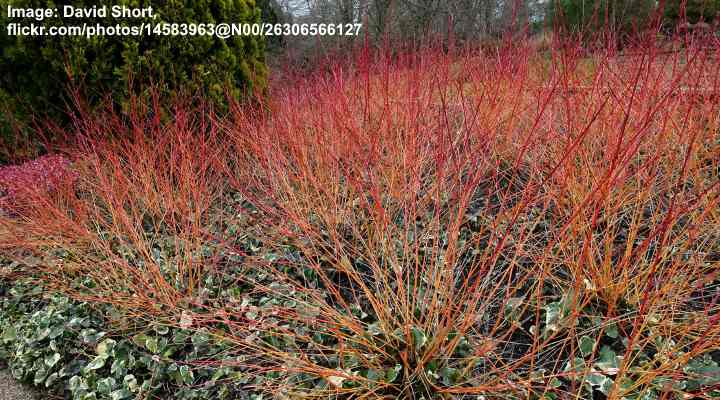
Red twig dogwood shrubs add beautiful color to your garden in winter. In the picture: Cornus sanguinea ‘Anny’s Winter Orange’
The red twig dogwood plant is a group of flowering shrubs in the genus Cornus and the family Cornaceae. These medium to tall deciduous shrubs are famous for colorful bark in various red shades — from bright lipstick red to deep burgundy red. Dogwoods with red bark grow between 5 and 13 ft. (1.5 – 4 m) tall.
Red stem dogwood shrubs are ideal for adding bright colors to a drab winter garden. The hardy shrubs thrive in USDA zones 3 through 8. In winter, their spectacular red branches stand out against brown or gray leafless shrubs and trees. Regular trimming keeps the shrub’s twigs vibrant red from year to year.
Red bark dogwoods are relatively fast-growing, low-maintenance shrubs. They will average about 24” (60 cm) of new growth annually in proper conditions. For the most vibrant red colors, dogwoods perform best in full sun or partial shade. In the spring, white flowers appear, followed by clusters of white fruits in summer.
Dogwood shrubs are also suitable as deciduous hedge plants. Planting red-stemmed dogwoods in a row creates a flowering privacy screen from spring until summer. Then after the leaves drop in the fall, beautiful orange, coral red, deep red, and pinkish-red colors create a spectacular screen.
Related reading: A complete guide to dogwood trees.
Red Twig Dogwood Leaves
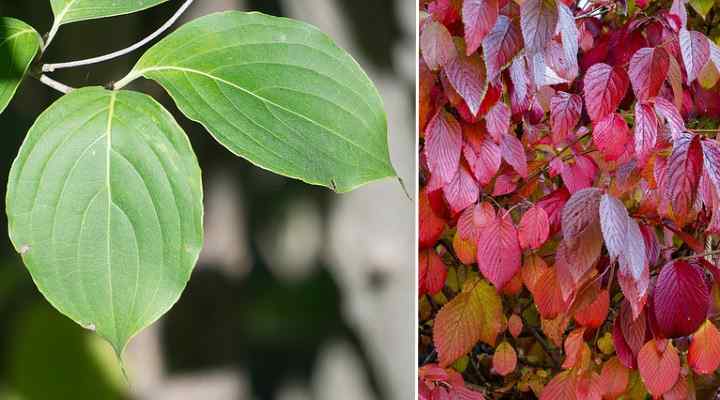
Dogwood leaves turn beautiful reddish color in autumn
Leaves on red twig dogwood trees are lance-shaped or oval with light to dark green upper sides and lighter undersides and smooth edges. The dogwood leaves are identified by their pronounced veins and somewhat wrinkled appearance. Red twig dogwood leaves measure 2” to 4.5” (5 – 12 cm) long.
Red twig dogwoods are known for their spectacular fall colors. The showy leaves turn from green into stunning shades of reds, yellows, and purples. As the leaves change, they may take on a patchy appearance with green, red, and yellow colors all on the same leaf.
Red Twig Dogwood Bark
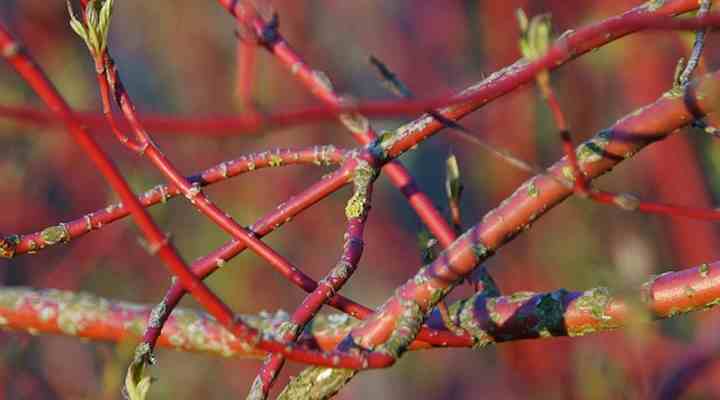
Red twig dogwood bark
Red bark is a characteristic feature of many dogwood shrubs. The thin dogwood twigs turn various shades of red in late fall and winter when it becomes cold. Depending on the species of dogwood shrub, the colors can range from bright crimson-red to coral red and deep wine red.
Regular pruning ensures that dogwood shrubs turn vibrant red colors in the fall. The best color appears on new growth, and older twigs tend to stay grayish-brown. For best fall colors, prune one-third of the shrub’s twigs in winter while the plant is dormant. Then, the following fall you will enjoy the vibrant red dogwood stems.
Red Twig Dogwood Berries
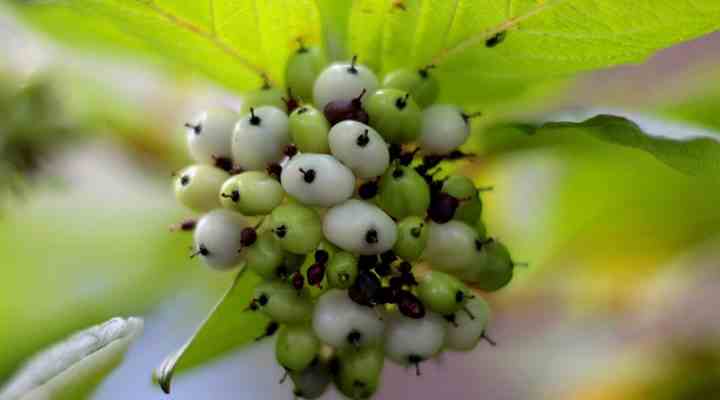
Red twig dogwood berries are food source for birds
Berry-like drupes on red twig dogwood shrubs appear in summer after flowering. The attractive shrubs produce clusters of small round pea-sized white berries. These white berry clusters contrast nicely with the red stems and green foliage. Dogwood berries are not said to be poisonous; however, they could cause gastrointestinal upset in animals.
Red Twig Dogwood Flowers
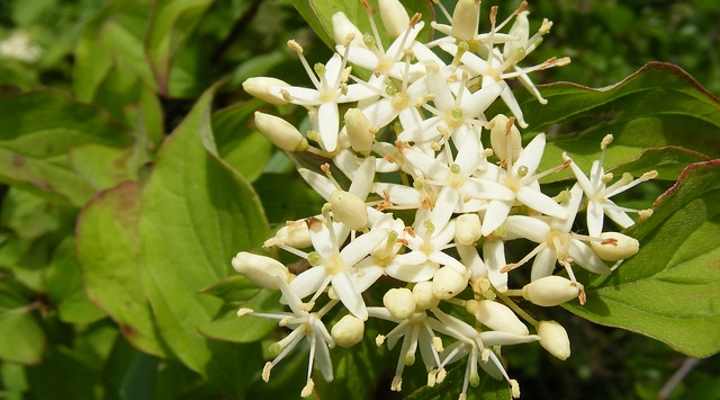
Red twig dogwood flowers
White flowers grow on red twig dogwood shrubs. The creamy white flowers grow in flat-topped clusters (cymes) that are around 2” (5 cm) wide. Dogwood flowers bloom in late spring and persist through midsummer. The attractive white flower clusters consist of tiny white, four or five-petalled star-shaped flowers with showy stamens.
Related reading: Spectacular white flowering shrubs for your garden.
Red Twig Dogwood Identification
Red twig dogwood shrubs are easy to identify due to their distinctive red winter and fall colors and clusters of creamy-white flowers. During spring and summer, white flowers and berries grow among lush green foliage that turns red in the fall. After the leaves drop, brightly colored red stems are clearly visible.
Types of Red Twig Dogwood (With Pictures)
Let’s look in more detail at some of the most common, red-stemmed dogwood shrubs that are easy to grow in a sunny front or backyard.
Red-Barked Dogwood (Cornus alba)
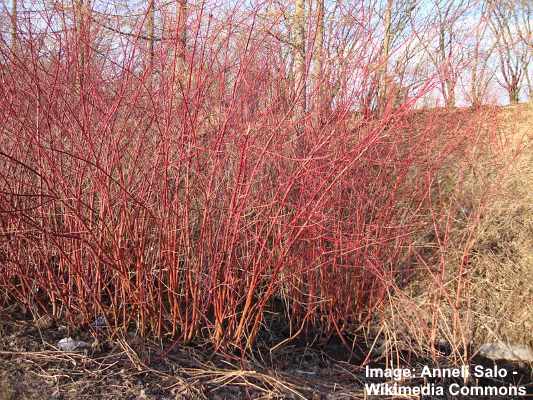
Red-barked dogwood (Cornus alba)
Red-barked dogwood is a flowering ornamental shrub with red stems that appear from fall through late winter. The landscape shrub has distinctive thin orangey-red twigs. This dogwood has dark green lanceolate leaves, clusters of white flowers, and white berries. Red-barked dogwood grows in thickets 8 to 10 ft. (2.4 – 3 m) high.
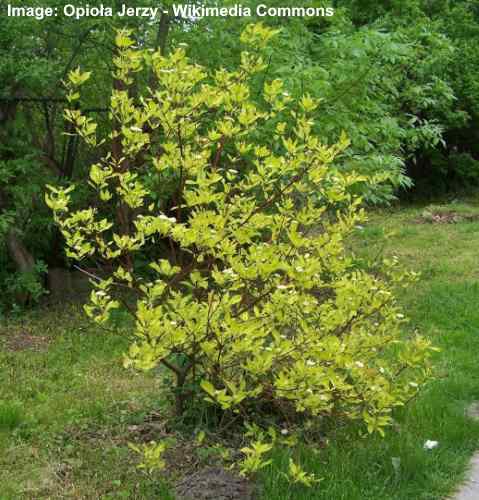
Cornus alba shrub
The red twig dogwood thrives in moist soils in USDA zones 3 through 7.
Other Cornus alba cultivars have variegated leaves or bright yellow leaves. The red-barked dogwood ‘Sibirica’ (Siberian dogwood or Tatarian dogwood) has coral red stems and bluish fruit.
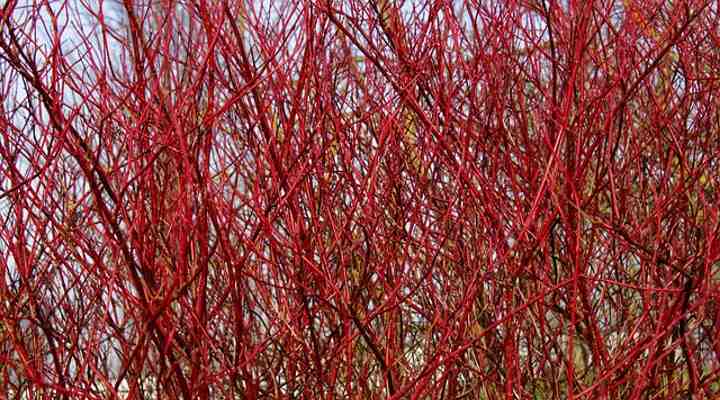
Cornus alba ‘sibirica’
Red-barked dogwood flowers: Red-barked dogwood is identified by flat-topped clusters of creamy white blooms.

Cornus alba flowers and leaves
Red-barked dogwood fruit: Look for white berry-like drupes with a bluish tinge growing in clusters throughout summer until fall.

Cornus alba berries and autumn foliage
Red-barked dogwood bark: The bark on this dogwood variety is orangey-red to burgundy-red.
Red-barked dogwood leaves: The upper leaf surface is green in the summer, turning to shades of yellow or reddish-purple in the fall.
Red Osier Dogwood (Cornus sericea)
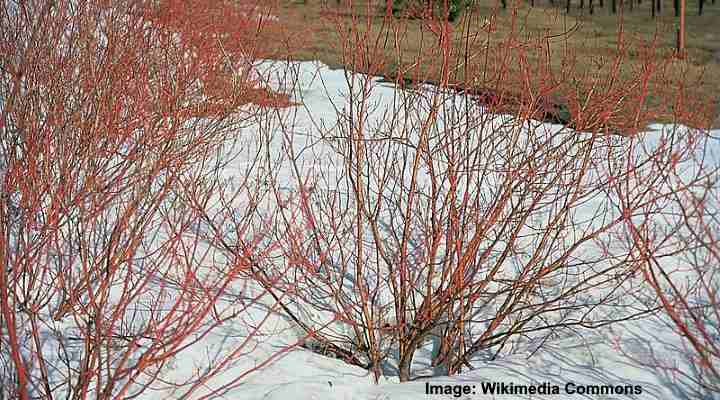
Red osier dogwood (Cornus sericea)
The red osier dogwood shrub is a flowering ornamental bush. This beautiful shrub is identified by its vibrant red stems, attractive white berries, and pointed oblong leaves that turn red or purple in the fall. Also called the American dogwood, this species is fast-growing and grows 5 to 13 ft. (1.5 – 4 m) tall.

Cornus sericea shrub
The common name red osier refers to its resemblance to red willow shrubs. Other names for this popular red twig dogwood include red stem dogwood, creek dogwood, red willow, and western dogwood. This species is one of the hardiest dogwoods and withstands freezing temperatures in zone 2.
Red osier dogwood flowers: Red osier dogwood has distinctive dense clusters of creamy-white flowers that bloom in mid-spring.
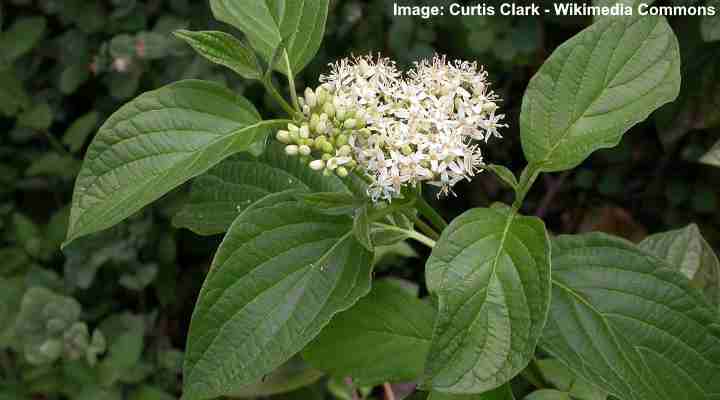
Cornus sericea leaves and flowers
Red osier dogwood fruit: White berries with a bluish tinge growing on red stems help identify the red osier dogwood in late summer.
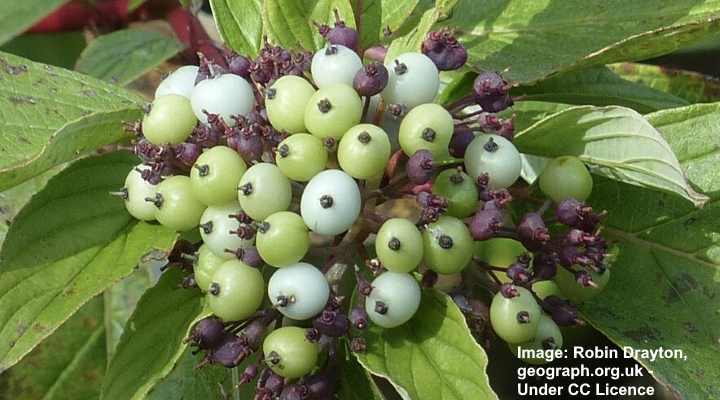
Cornus sericea berries
Red osier dogwood bark: Vibrantly colored red stems make the multi-stemmed shrub prominent in winter.
Red osier dogwood leaves: The lanceolate medium to dark green, veined leaves measure 2” to 5” (5 – 13 cm) long and turn orange, red, and purple in the fall.
Common Dogwood (Cornus sanguinea)
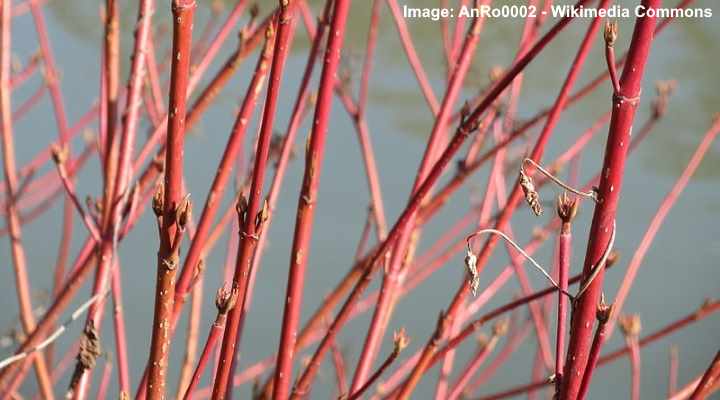
Common dogwood (Cornus sanguinea)
Also called bloodtwig dogwood, the common dogwood is a bushy, upright, multi-stemmed red shrub. The red twig dogwood is identified by its clusters of small white flowers, purplish-black berries, furry leaves, and dark red stems. Common dogwood shrubs grow 8 to 15 ft. (2.4 – 4.5 m) tall and up to 15 ft. (4.5 m) wide.
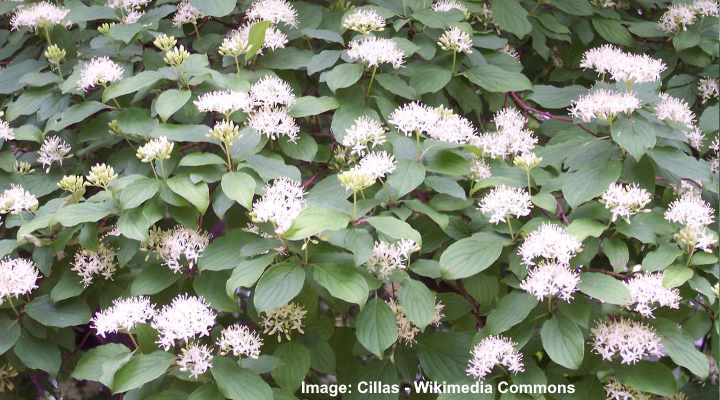
Cornus sanguinea flowers and leaves
One of the distinctive features of common dogwood shrubs is the clusters of dark purple or black drupes. These black berry-like drupes mature in late summer and attract birds and wildlife to gardens. In addition, the low-maintenance shrub has ornamental interest in all four seasons as a shrub border, screening plant, or hedge.
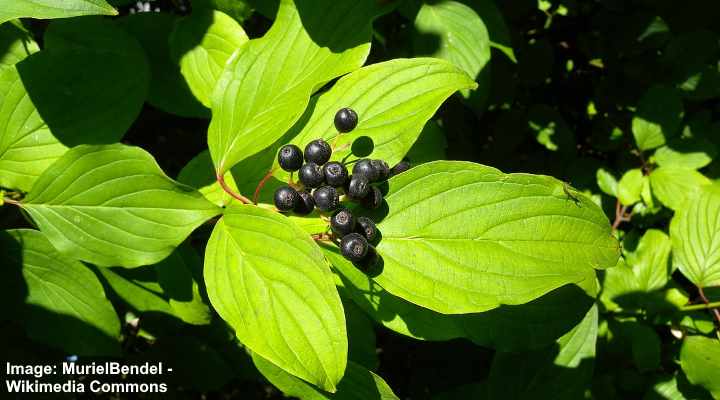
Cornus sanguinea berries
Common dogwood flowers: Identifiable features of common dogwood flowers are soft white blooms growing in flat clusters measuring 2” (5 cm) across.
Common dogwood fruit: Clusters of bitter black or dark blue fruits are the identifying feature of the red twig common dogwood tree.
Common dogwood bark: The common dogwood has recognizable burgundy red or purple-red bark with distinctive lenticels on the twigs.
Common dogwood leaves: The common dogwood has dark green leaves that measure 2” to 4” (5 – 10 cm) long. Common dogwood leaves turn reddish-purple in the fall.
Variegated Red Twig Dogwood (Cornus alba ‘Elegantissima’)
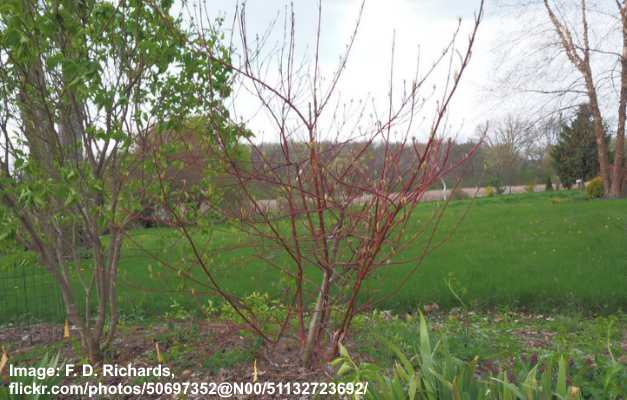
Variegated red twig dogwood (Cornus alba ‘Elegantissima’)
The variegated, red-barked dogwood is identified by its narrowly ovate gray-green leaves with creamy-white margins. The fast-growing multi-stemmed shrub grows up to 10 ft. (3 m) tall and wide. The variegated dogwood foliage contrasts nicely with clusters of tiny creamy-white flowers and white berries.
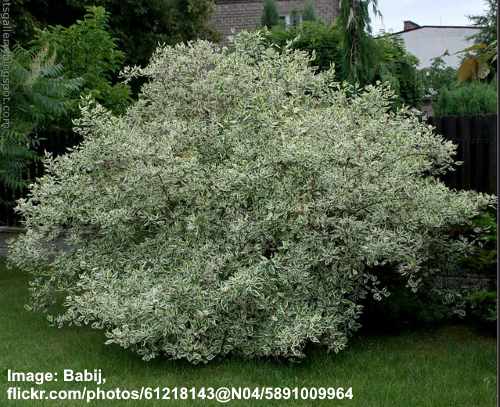
Cornus alba ‘Elegantissima’ shrub
This variegated variety doesn’t have spectacular fall leaf colors characteristic of most dogwood bushy shrubs.
Variegated red-barked dogwood flowers: This variegated cultivar has white clusters of dense flowers like the dogwood species plant.

Cornus alba ‘Elegantissima’ flowers and leaves
Variegated red-barked dogwood fruit: The Cornus alba ‘Elegantissima’ has clusters of white berries growing on coral-red stems.
Variegated red-barked dogwood bark: Deep red thin stems growing in spreading thickets is characteristic of this dogwood species.
Variegated red-barked dogwood leaves: The gray-green and white leaves on the variegated dogwood are slender, lance-shaped, that turn yellow in the fall before dropping to reveal dark red twigs.
Cardinal Red Twig Dogwood (Cornus sericea ‘Cardinal’)

Cardinal red twig dogwood (Cornus sericea ‘Cardinal’)
The cardinal red twig dogwood is a decorative multi-stemmed, suckering shrub with vibrant, glossy red stems. The four-season interest of this dogwood cultivar is due to its clusters of white flowers in spring, dark green leaves in the summer, blue-tinged white berries in the fall, and cardinal red winter stems.
Cardinal red twig dogwood shrubs grow 6 to 9 ft. (1.8 – 2.7 m) tall. However, regular pruning is required to control its height as a foundation plant, shrub border, or screening plant. Also, pruning in winter ensures new vibrantly colored burgundy-red stems grow year after year.
Cardinal red twig dogwood flowers: A characteristic feature of the cardinal red twig dogwood is small dense clusters of tiny star-shaped creamy flowers blooming in late spring.
Cardinal red twig dogwood fruit: Clusters of small white fruits — berry-like drupes appear in midsummer after flowering.
Cardinal red twig dogwood bark: The identifying feature of the dogwood ‘Cardinal’ shrub is its rusty-red colored, upright growing thin twigs.
Cardinal red twig dogwood leaves: This dogwood variety has dark green leaves covering the ornamental shrub that turn attractive shades of burgundy red in the fall.
Arctic Fire Red Twig Dogwood
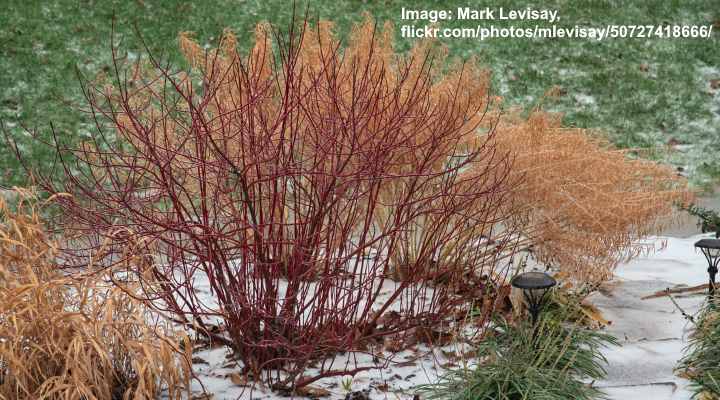
Arctic Fire red twig dogwood
‘Arctic Fire’ dogwood is a flowering dwarf ornamental shrub with bright red stems that add color to a winter landscape. The shade-tolerant miniature shrub grows 3 to 5 ft. (1 – 1.5 m). The ‘Arctic Fire’ red twig dogwood has dark green foliage, white flower clusters, white berries, and burgundy-red leaves in the fall.
The red twig dogwood ‘Arctic Fire’ is the most shade tolerant of all the dogwood varieties. The dwarf shrub produces vibrant colors when grown in part shade or full shade. And it also tolerates full sun. Due to its short growth habit, the ‘Arctic Fire’ dogwood is suitable for growing in containers.
‘Arctic Fire’ dogwood flowers: The characteristic feature of this dogwood is its small flat-topped cymes consisting of tiny creamy-white flowers.
‘Arctic Fire’ dogwood fruit: After flowering, the ‘Arctic Fire’ dogwood produces clusters of white berries with a yellowish-green tinge.
‘Arctic Fire’ dogwood bark: The red twig ‘Arctic Fire’ dogwood has beautiful bright red stems and a compact habit.
‘Arctic Fire’ dogwood leaves: The compact, ornamental dwarf shrub produces spectacular fall colors when the dark green lanceolate leaves turn deep red.
Bailey Red Twig Dogwood (Cornus sericea ‘Baileyi’)

Bailey red twig dogwood (Cornus sericea ‘Baileyi’)
The red twig dogwood cultivar ‘Baileyi’ is a fast-growing, brightly-colored, red-stemmed shrub with pointed leaves, white flowers, and white fruits. Growing 5 to 6 ft. (1.5 – 1.8 m) tall, the ornamental Bailey’s red twig dogwood shrub is suitable for small garden landscapes. In the fall, the green foliage turns to deep purple shades.
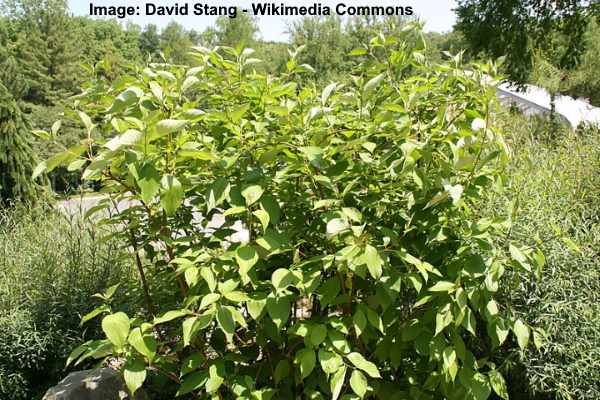
Cornus sericea Baileyi shrub
One of the unique features of Bailey’s red twig dogwood is that it doesn’t spread. Unlike other types of dogwoods, this red-stemmed variety doesn’t have a suckering habit. The stems become bright red in late fall and winter when growing in full sun.
Bailey red twig dogwood flowers: The dwarf dogwood shrub has clusters of milky-white flowers growing in flat-topped cymes.
Bailey red twig dogwood fruit: Small purple berries emerge after flowering and they gradually turn white with a bluish tinge through summer and fall.
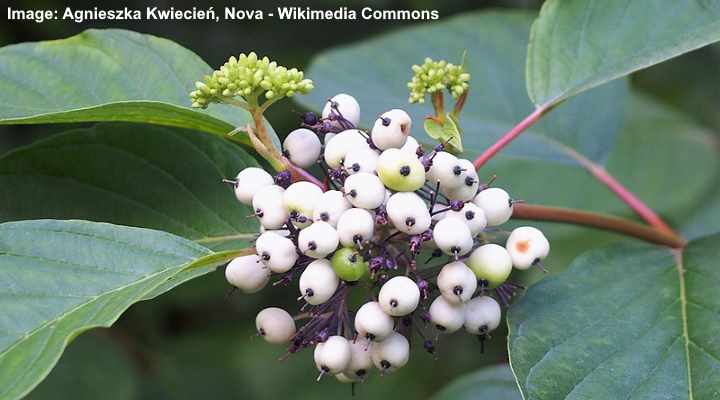
Cornus sericea Baileyi berries
Bailey red twig dogwood bark: Young stems on Bailey red twig dogwood emerge bright red, adding plenty of color to a drab winter landscape.
Bailey red twig dogwood leaves: Bailey’s dogwood has distinctive triangular-shaped, pointed, dark green leaves that turn a dark red wine color in the fall.
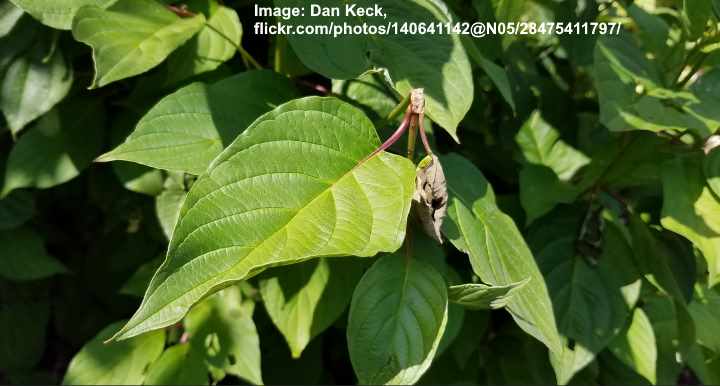
Cornus sericea Baileyi leaves
Bloodtwig Dogwood ‘Midwinter Fire’ (Cornus sanguinea ‘Midwinter Fire’)
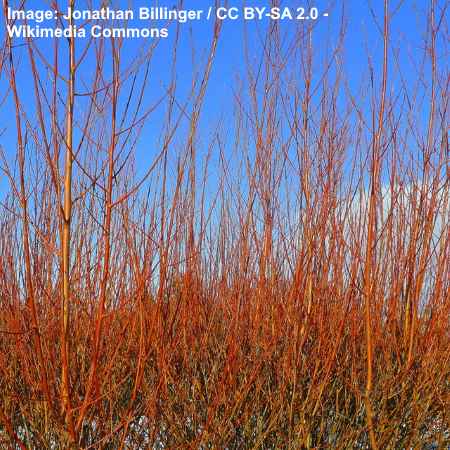
Bloodtwig dogwood ‘Midwinter Fire’ (Cornus sanguinea ‘Midwinter Fire’)
The red twig dogwood ‘Midwinter Fire’ is a colorful ornamental shrub, identified by its yellowish-orange and red stems in winter. The outstanding growth features of the ‘Midwinter Fire’ dogwood are medium green, ovate leaves that turn golden yellow, white flower clusters, and dark purple drupes. This dogwood cultivar grows up to 6 ft. (1.8 m) tall and 6 ft. (1.8 m) wide.
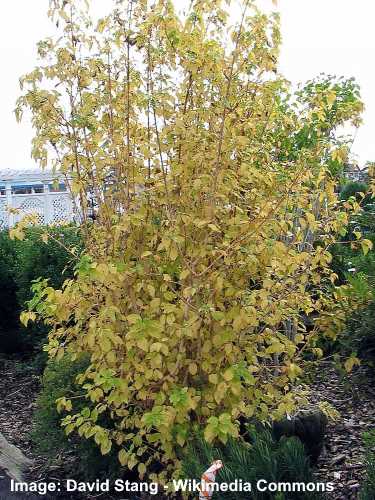
Cornus sanguinea ‘Midwinter Fire’ shrub
‘Midwinter Fire’ red twig dogwood flowers: Cymes of fragrant white flowers appear in late spring.
‘Midwinter Fire’ red twig dogwood fruit: The identifying feature of this dwarf dogwood is its clusters of small dark purple berries that appear in summer.
‘Midwinter Fire’ red twig dogwood bark: Unlike most dogwoods, the ‘Midwinter Fire’ has stems that are more yellow or orange than bright red. However, they provide a warm, colorful shade of orange in winter landscapes.
‘Midwinter Fire’ red twig dogwood leaves: The lanceolate or ovate medium green leaves turn golden yellow in the fall.
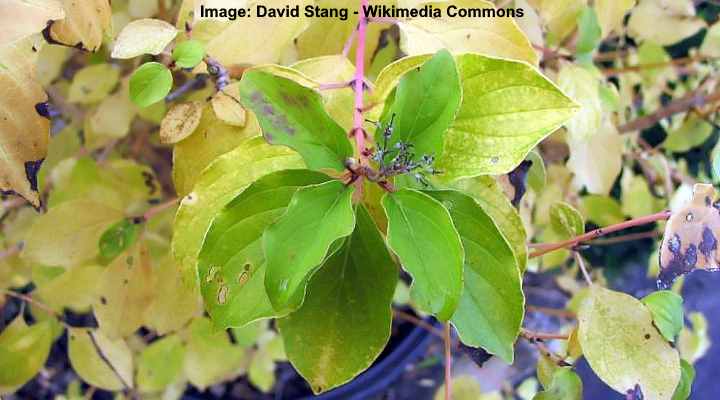
Cornus sanguinea ‘Midwinter Fire’ leaves
How to Care for Red Twig Dogwood Shrubs
To grow red twig dogwood shrubs in your garden, plant the ornamental bushes in full sun to partial sun. Red-stemmed dogwoods thrive in moist, well-drained, slightly acidic soil. Only water mature dogwood shrubs during dry spells. Prune one-third of the stems in winter and fertilize in spring with organic compost.
Planting in full sun and annual pruning are the best ways to ensure bright red stems grow on ornamental dogwood year after year.
Related articles:
